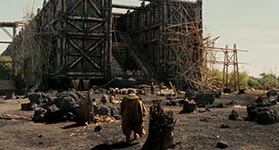ARABIAN CULTURE
013 'arab culture' - Alexander is Lowered into the Sea
Alexander the Great was wondering about the underworld and here you can see him in a self designed, probably the first ever, diving bell. The story continues with that a fish was so large it took all day to swim past Alexander's little window.Folio from a Khamsa (Quintet) of Amir Khusrau Dihlavi (1253-1325). Date: 1597-98 Medium: Main support: Ink, watercolor, gold on paper Margins: Gold on dyed paper
"Alexander the Great (356-323BC) was a king of Macedon, an ancient kingdom on the northern periphery of Classical Greece and later the dominant state of Hellenistic Greece. By the age of thirty, he had created one of the largest empires of the ancient world, stretching from Greece to Egypt and into northwest India. He was undefeated in battle and is considered one of history's most successful military commanders." Wikipedia
©: MET, NYC
Diving bells and Observation chambers: www.divingheritage.com
tags: #Alexander the Great #bathyscaphe #diving bell
013a 'arab culture' - Alexander the Great
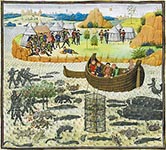 "Just as divers are sometimes provided with instruments for respiration, through which they can draw air from above the water, and thus may remain a long time under the sea, so also have elephants been furnished by nature with their lengthened nostril; and, whenever they have to traverse water, they lift this up above the surface and breathe through it..." (Aristotle, Parts of Animals)
"Just as divers are sometimes provided with instruments for respiration, through which they can draw air from above the water, and thus may remain a long time under the sea, so also have elephants been furnished by nature with their lengthened nostril; and, whenever they have to traverse water, they lift this up above the surface and breathe through it..." (Aristotle, Parts of Animals)many more examples here: documents-macedon.blogspot.nl
©: Public Domain
, tags: #Alexander the Great #diving bell
013b 'arab culture' - Alexander the Great
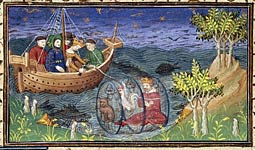 Quite another drawing of the same event shows his wife in the boat above Alexander holding a pair of scissors to cut his lifeline ..
Quite another drawing of the same event shows his wife in the boat above Alexander holding a pair of scissors to cut his lifeline ..Alexander exploring the ocean in a glass barrel, accompanied by a cat and a cock.
'Le livre et le vraye hystoire du bon roy Alixandre', France (Paris), c. 1420
©:
, tags: #Alexander the Great #diving bell
013c 'arab culture' -Diving Bell
 From Tartaglia's 1551: methods for raising sunken ships, which includes several designs for diving bells
From Tartaglia's 1551: methods for raising sunken ships, which includes several designs for diving bellswww.historytoday.com
©: Library of London
, tags: #diving bell #tartaglia
013d 'arab culture' -Alexander the Great under water
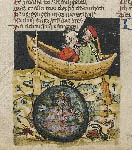 "Again, it looks like Alexander's life-line is detached and that his wife, in the boat, is conversing with another man. He looks a bit sour too .." text: RS
"Again, it looks like Alexander's life-line is detached and that his wife, in the boat, is conversing with another man. He looks a bit sour too .." text: RS"Beneath the surface of an ocean teeming with fish, King Alexander the Great sits in a bathysphere, a type of diving contraption, glowering as he raises his eyes to the couple above. Sitting in a boat, Alexander's mistress and her new suitor make eyes at each other and hold hands.
The story of Alexander's underwater adventure was invented and greatly elaborated upon during the course of the Middle Ages, especially in German vernacular literature. Alexander, who was a student of the great philosopher Aristotle, was curious to explore the ocean. He had himself lowered into the water in a glass diving bell, taking with him three creatures: a dog, a cat, and a cock. Alexander entrusted his most loyal mistress with looking after the chain that pulled the bell up to the surface. She was persuaded by her lover to elope, however, and she cast the chain into the sea. With the chain uselessly coiled on the ocean floor, Alexander was left to devise his own escape.
This miniature illustrates Jansen Enikel's contribution to the World Chronicle, the ancient history section."
artist: Unknown
'Alexander the Great under Water', (about 1400 - 1410) Tempera colors, gold, silver paint, and ink on parchment
Created in Regensburg, Germany. Leaf: 33.5 x 23.5 cm (13 3/16 x 9 1/4 in.)
©: text and picture PD: The J. Paul Getty Museum, Los Angeles
tags: #diving bell, #alexander the great, #getty museum
022f Arab culture -Babylonian Map
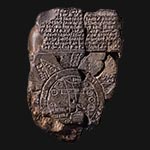 "The Babylonian map of the world sheds light on ancient perspectives. A damaged clay tablet discovered in the late 1800s in Sippar, Iraq is said to be the oldest map of the world. It was discovered on the banks of the Euphrates River, and published in 1899. Now housed at the British Museum, the damaged clay tablet dates back to 600 BC, and depicts an early interpretation of the layout of the world. At 122 x 82 mm, the small map gives us a glimpse into how the Babylonians viewed the world around them, both physically and spiritually.
"The Babylonian map of the world sheds light on ancient perspectives. A damaged clay tablet discovered in the late 1800s in Sippar, Iraq is said to be the oldest map of the world. It was discovered on the banks of the Euphrates River, and published in 1899. Now housed at the British Museum, the damaged clay tablet dates back to 600 BC, and depicts an early interpretation of the layout of the world. At 122 x 82 mm, the small map gives us a glimpse into how the Babylonians viewed the world around them, both physically and spiritually.The tablet contains a map of the Mesopotamian world, with Babylon in the center. It contains carefully etched images and cuneiform writing. Babylon is surrounded by two concentric circles that represent the ocean, named 'bitter water' or the 'salt sea'. It is labeled with Babylon, Assyria, and Elam. Eight triangular areas labeled as 'Regions' or 'Islands' surround the Salt Sea, and are labeled with distances, descriptions of the regions, and descriptions of great heroes and mythical beasts that lived in each region. The southern marshes are indicated at the bottom of the map by two parallel lines, and a curved line near the top shows the Zagros Mountains. The Euphrates River is shown running from the mountains above, through Babylon, to the marshes below. Within the center of the map are seven labelled areas that appear to represent cities. Due to damage of the tablet, it appears that three islands are missing from the lower corner."
Read more (and © above text): www.ancient-origins.net
© image: Creative Commons the British Museum
"The Babylonian Map of the World, Imago Mundi (c. 500 BC) is a diagrammatic labeled depiction of the known world from the perspective of Babylonia. The map is incised on a clay tablet, showing Babylon somewhat to the north of its center; the clay tablet is damaged, and also contains a section of cuneiform text.
It is usually dated to the 5th century BC. It was discovered at Sippar, southern Iraq, 60 miles (97 km) north of Babylon on the east bank of the Euphrates River, and published in 1899. The clay tablet resides at the British Museum (BM 92687).
It is conjectured that the island locations, though possibly referring to real areas, may also represent a mythological interpretation of the world.
Carlo Zaccagnini has argued that the Babylonian map of the world may have lived on in the T and O map of the European Middle Ages."
©: www.ancient-wisdom.com
more on this and other maps: www.gutenberg.org tags: #babylonian world map #clay tablet #British Museum
023 Arab culture -'Where the Two Seas Meet'
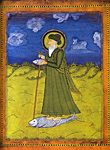 "The place where the two seas meet is the locus of the mystical journey, "where the dead fish becomes alive", where spiritual teachings become a living substance that nourishes the wayfarer. When we meet our teacher, when we meet our path, this is what happens; something becomes alive within our heart and soul: we become nourished not by spiritual texts or teaching, but by direct transmission. The spiritual journey is a way to live with this spiritual substance, to be burned by its fire, to be consumed by its love."
"The place where the two seas meet is the locus of the mystical journey, "where the dead fish becomes alive", where spiritual teachings become a living substance that nourishes the wayfarer. When we meet our teacher, when we meet our path, this is what happens; something becomes alive within our heart and soul: we become nourished not by spiritual texts or teaching, but by direct transmission. The spiritual journey is a way to live with this spiritual substance, to be burned by its fire, to be consumed by its love."- Llewellyn Vaughan-Lee, 'Where the Two Seas Meet': A Sufi master's reflections on the divine and the human, Parabola Magazine, Spring 2012, 'Burning World.'
As we say whenever Hazrat al-Khezr's name is mentioned, "as-salaam aliekum", Blessing to the enigmatic and immortal Green Saint.
©: Illustration of the Sufi Saint Khidr (the Green One) W, ring A Green Robe and Standing on a Fish that carries him over Water, circa 1700. Public Domain
tags: #'Where the Two Seas Meet' #arab culture
023a Arab culture -'The Drowning of the Chinese Beauty'
 A folio from the Aiyar-e-Danish (A Book of Animal Fables)
A folio from the Aiyar-e-Danish (A Book of Animal Fables)Mughal, Reign of Akbar, 1596-7
Painter: MISHKIN, size: 24.8 x 13.9 cm., Bharat Kala Bhavan, (Varanasi, India) No. 9065/22
"This startling miniature, one of the finest from the brush of the well-known master Mishkin, illustrates the story of the King of Baghdad getting rid of a beautiful Chinese damsel by drowning her in the waters of the Tigris. It was necessary for him to do this in order to overcome his mad infatuation for her so that he could fulfill the greater need of his distressed subjects who he had been badly neglecting. Mishkin has captured the dramatic moment when the king himself undertook this terrible task as earlier attempts to eliminate her were unsuccessful."
©: PD; description: Alok Kumar Das; miniature from Banaras Hindu University, Varanasi India
tags: #BHU #Mishkin #mniature painting #Baghdad
024 Arab culture -Noah's Ark
"Noah, his head surrounded by a flaming halo, sits at the center of this painting. A popular figure in the Koran, Noah (in Arabic, Nuh) also figures in poetic texts such as the Diwan (Collected Poems) by Hafiz.Miskin, one of the greatest painters in the workshop of the Mughal emperor Akbar (r. 1556-1605) is thought to have painted this page. An expert draftsman and colorist, Miskin was best known for his skilled and whimsical depictions of animals and birds."
A Mughal miniature of Noah's Ark in the collection of the Freer Gallery of Art, Smithsonian Institution, Washington, D.C.
"Commanding Prophet Noah to warn his people, God said: "Warn your people before there comes upon them a grievous penalty." - Holy Qur'an, 57:61 Obeying the command of God, Prophet Noah went to his people and said: "I have come to you with a clear warning that you worship none but God. Verily I fear for you the penalty of a grievous day." - Holy Qur'an, 11:25-26
©: text: simerg.com By Jehangir A. Merchant
©: image: PD(India); Description: Noah's Ark ca. 1590, Miskin Mughal dynasty Akbar(r. 1556 - 1605), Color and gold on paper H: 28.1 W: 15.6 cm India Source: www.asia.si.edu
tags: #noah's ark
024a Arab culture -Noah's Ark and Floods
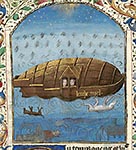 "Le Livre des hystoires du Mirouer du monde, depuis la création, jusqu'après la dictature de Quintus Cincinnatus Date d'édition: 1401-1500 Type: manuscrit Langue: Français Identifiant: ark:/12148/btv1b52000962r"
Pinterest
"Le Livre des hystoires du Mirouer du monde, depuis la création, jusqu'après la dictature de Quintus Cincinnatus Date d'édition: 1401-1500 Type: manuscrit Langue: Français Identifiant: ark:/12148/btv1b52000962r"
Pinterest©: PD, gallica.bnf.fr
Here is a link with many interesting stories about flood from all around the world. The image is not necessarily related to the following text:
"Zeus sent a flood to destroy the men of the Bronze Age. Prometheus advised his son Deucalion to build a chest. All other men perished except for a few who escaped to high mountains. The mountains in Thessaly were parted, and all the world beyond the Isthmus and Peloponnese was overwhelmed. Deucalion and his wife Pyrrha (daughter of Epimetheus and Pandora), after floating in the chest for nine days and nights, landed on Parnassus. When the rains ceased, he sacrificed to Zeus, the God of Escape. At the bidding of Zeus, he threw stones over his head; they became men, and the stones which Pyrrha threw became women. That is why people are called laoi, from laas, "a stone."
©: www.talkorigins.org
tags: #noah's arc #flood
ref. # 024b Arab culture -NOAH, the movie
 A man is chosen by his world's creator to undertake a momentous mission before an apocalyptic flood cleanses the world.
Writers: Darren Aronofsky, Ari Handel. Stars: Russell Crowe, Jennifer Connelly, Anthony Hopkins
A man is chosen by his world's creator to undertake a momentous mission before an apocalyptic flood cleanses the world.
Writers: Darren Aronofsky, Ari Handel. Stars: Russell Crowe, Jennifer Connelly, Anthony Hopkins©:
tags: #noah
ref. # 024d Arab culture -Noah's Ark
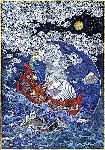 Floating Facts
Floating FactsAccording to Genesis, the Ark was 450 x 75ft and 45ft high - that is taller than a three-storey building and with a deck area the size of 36 tennis courts. A replica of the Ark is being built at Frostburg, Maryland. Work began 30 years ago.
Christians argue that Noah needed 40,000 animals to represent every kind of creature. sceptics say Noah would have needed room for at least 1.5 million species. The story may be based on an earlier, and very similar, Babylonian flood tale from the epic of Gilgamesh.
Noah, or Nuh, is one of the main prophets of Islam. In the Koran his wife is said to drown in the flood.
planet.infowars.com with many links!!
Noah Builds an Altar
20 Then Noah built an altar to the LORD, and took of every clean animal and of every clean bird and offered burnt offerings on the altar.
21 The LORD smelled the soothing aroma; and the LORD said to Himself, "I will never again curse the ground on account of man, for the intent of man's heart is evil from his youth; and I will never again destroy every living thing, as I have done.
22 "While the earth remains, Seedtime and harvest, And cold and heat, And summer and winter, And day and night Shall not cease."
©:
tags: #noah's ark
ref. # 024e Arab culture -Noah's Ark (steampunk)
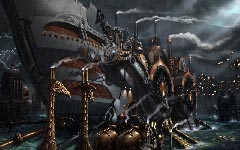 ©: 'wallpaper' www.wall321.com
©: 'wallpaper' www.wall321.comtags: #noah ark #steampunk #wallpaper
ref. # 024f Arab culture -Noah's Ark
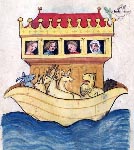 When you know more about this artwork, please let me know (robert@WATER-artproject.com)
When you know more about this artwork, please let me know (robert@WATER-artproject.com)©: unknown (yet)
, tags: #Noah #Arc
ref. # 024g Arab culture -Noah's Ark
 MOUNT ARARAT
MOUNT ARARATThe highest mount in Anatolia is Mount Ararat, called A&gcedil;ri Da&gcedil;i in Turkish, a volcano that culminates at 5,165 m/ 16,945 ft and whose summit is always capped with snow. The last eruption dates back to June 20, 1840. Many expeditions took place, some of which aiming to find the remains of Noah's Ark that is thought to have landed there after the Deluge.
www.guide-martine.com
©: unknown
, tags: #arab culture #noah's ark
ref. # 024h Arab culture -Secrets of Noah's Ark
 A team attempts to build the flood boat using inscriptions from an ancient clay tablet
A team attempts to build the flood boat using inscriptions from an ancient clay tablet"Program Description:
In 1948, a British pilot serving in Iraq acquired a clay tablet with an intriguing, 3,700 year-old inscription. The ancient writing tells the story of how the god Enki warns a Sumerian king named Atra-Hasis of a future flood that will destroy mankind; Enki gives him instructions for building a boat to save his family and livestock. If that sounds like a familiar tale, it's because this was one of several ancient flood traditions that, centuries later, would inspire the biblical story of Noah. But the tablet's inscription describes a boat very different from the traditional image of the Ark -it's said to be circular and made of reeds. Is this nothing more than a fanciful myth? Or could such a reed boat have carried Atra-Hasis' family of more than one hundred and his many animals? Join NOVA as a team of historians and expert boat builders investigates this fascinating flood legend and sets out to rebuild a tantalizing, ancient forerunner of the Ark"
©: unknown (yet)
tags: noah's ark
ref. # 024i Arab culture -Noah's Ark
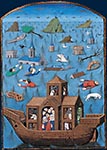 Bibliothéque nationale de France, Français 28. f. 66v (Noah's ark). St Augustine, De civitate dei. Rouen, 3rd quarter of the 15th century.
Bibliothéque nationale de France, Français 28. f. 66v (Noah's ark). St Augustine, De civitate dei. Rouen, 3rd quarter of the 15th century.©: BNF; via: Tumblr
tags: noah's ark
ref. # 024j Arab culture -Noah's Ark
 "A page from a Book of Hours produced in Normandy in the mid 15th century, probably for export to England, with work by an artist known as the Master of Sir John Fastolf. The book may have had a royal owner. The page is heavily decorated with a floral border in bright colours. The image of the ark floating on water is above several lines of a prayer, in French and Latin, asking for 'peace in our time'. The image of Noah and his family in the ark (a simple wooden structure) is rather simple, as is the benign figure of God the Father who watches over the scene from the top of the page, above a rainbow. There is no sign of animals in the ark."
"A page from a Book of Hours produced in Normandy in the mid 15th century, probably for export to England, with work by an artist known as the Master of Sir John Fastolf. The book may have had a royal owner. The page is heavily decorated with a floral border in bright colours. The image of the ark floating on water is above several lines of a prayer, in French and Latin, asking for 'peace in our time'. The image of Noah and his family in the ark (a simple wooden structure) is rather simple, as is the benign figure of God the Father who watches over the scene from the top of the page, above a rainbow. There is no sign of animals in the ark."Manuscript 15th century, Bodleian Library, Oxford (Ms Auct D, fol 59v)
©: BNF; via: www.english.cam.ac.uk
tags: noah's ark #Bodleian Library
ref. # 025 Arab culture -al-Idrisi
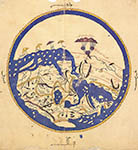 Ash-Sharīf al-Idrīsī, byname of Abī 'abd Allāh Muḥammad Ibn Muḥammad Ibn 'abd Allāh Ibn Idrīs Al-ḥammīdī Al-ḥasanī Al-idrīsī (born 1100, Sabtah, Mor.- died 1165/66, Sicily, or Sabtah), Arab geographer, an adviser to Roger II, the Norman king of Sicily. He wrote one of the greatest works of medieval geography, Kitāb nuzhat al-mushtāq fī ikhtirāq al-āfāq ("The Pleasure Excursion of One Who Is Eager to Traverse the Regions of the World")
Ash-Sharīf al-Idrīsī, byname of Abī 'abd Allāh Muḥammad Ibn Muḥammad Ibn 'abd Allāh Ibn Idrīs Al-ḥammīdī Al-ḥasanī Al-idrīsī (born 1100, Sabtah, Mor.- died 1165/66, Sicily, or Sabtah), Arab geographer, an adviser to Roger II, the Norman king of Sicily. He wrote one of the greatest works of medieval geography, Kitāb nuzhat al-mushtāq fī ikhtirāq al-āfāq ("The Pleasure Excursion of One Who Is Eager to Traverse the Regions of the World")© text: https://www.britannica.com, map: Wikipedia PD
tags: #arab culture #al-Idrisi
ref. # 025a Arab culture -Dhow Ports in the Indian Ocean.
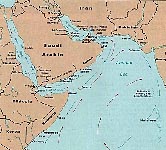 In the time Ibn Battuta 028b lived (14th century), Muslim traders had firm control over the western half of the Indian Ocean trading centers. It was like "a Muslim lake" around which Muslim merchants had started businesses and they depended on trade by ship. Muslim communities had developed along the coast of Africa and later would develop along the coasts of India and Southeast Asia. A place in the business community was open to any young man with brains and ambition - whatever his racial background - íf he was a Muslim.
In the time Ibn Battuta 028b lived (14th century), Muslim traders had firm control over the western half of the Indian Ocean trading centers. It was like "a Muslim lake" around which Muslim merchants had started businesses and they depended on trade by ship. Muslim communities had developed along the coast of Africa and later would develop along the coasts of India and Southeast Asia. A place in the business community was open to any young man with brains and ambition - whatever his racial background - íf he was a Muslim.©: ibnbattuta.berkeley.edu
tags: #indian ocean #dhow
ref. # 025b Arab culture -Astrolabe
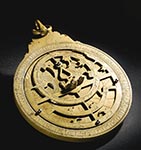 A royal brass astrolabe, one of two known pieces, made by al-Ahmar al-Nujumi al-Rumi for the treasury of the Ottoman Sultan Bayezid II (r.1481-1512), Turkey, dated 911 AH/1505-6 AD; comprising a mater with a double loop for suspension, three discs and an alidade, with incised details, the reverse-with two calligraphic roundels, the pin modern, 9.5cm. diam.
A royal brass astrolabe, one of two known pieces, made by al-Ahmar al-Nujumi al-Rumi for the treasury of the Ottoman Sultan Bayezid II (r.1481-1512), Turkey, dated 911 AH/1505-6 AD; comprising a mater with a double loop for suspension, three discs and an alidade, with incised details, the reverse-with two calligraphic roundels, the pin modern, 9.5cm. diam.©: www.sothebys.com
tags: #astrolabe, #sothebys #navigation
ref. # 025c Arab culture - map of Mali
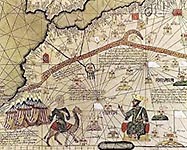 "14th century map showing MANSA MUSA reigning in Mali", reportedly the richest man EVER.
"14th century map showing MANSA MUSA reigning in Mali", reportedly the richest man EVER.©: www.mufudza.com
tags: #mansa musa
025d Arab culture -´Sea Serpent swallows the Royal Fleet´
 "Folio From The Khawass Al-Ashjar (de Materia Medica): Rasiyun, Iran, 13th century CE
"Folio From The Khawass Al-Ashjar (de Materia Medica): Rasiyun, Iran, 13th century CEA giant sea serpent constricts its gold coils around a royal fleet, its full mouth leaving no doubt as to its intentions toward the remaining vessels. As if the carnivorous serpent were not enough, the alternative is a scary sea filled with demon-headed fish, giant crabs, and turtles, as well as a mermaid and merman. Most of the sailors appear to pray with upturned hands for deliverance from this nightmare. The painting has been identified as an illustration from the Gulshan-i 'Ishq (Rose Garden of Love) a heroic epic written in Deccani Urdu by the court poet Nusrati for Sultan 'Ali II ibn Muhammad 'Adil Shahi (r. 1656-72 CE) (Falk 1985, p. 174). The 'Adil-Shahis were great patrons of the arts and ruled Deccani Bijapur as an independent Shia kingdom from 1489 CE until it became part of the Mughal Empire in 1689 CE. It has been suggested that this painting was produced for an aristocrat at the end of Sultan 'Ali´s reign or during the reign of his successor, Sikandar ´Ali Shah (r. 1672-86 CE) (Welch and Welch 1982, p. 229). The theme of disaster at sea in this painting may be compared with similar episodes in the Hamzanama as part of the picaresque genre of adventure-romances, featuring heroes who travel through strange lands and meet with danger on land and sea."
Place: Bijapur, Deccan, India Dimensions: 39x23.5 cm Date: 1670 Materials and Technique: Opaque watercolour, paper
©: www.agakhanmuseum.org (encouraged to share via FB)
tags: #Aga Khan Museum
013c 'arab culture' -Videns Deus quo´d multa malitia hominum
Grabado bíblico en aguafuerte de 1748 por Los Hermanos Klaubergrabadosantiguoslanzarote.com
tags: #in the beginning #noah's ark


